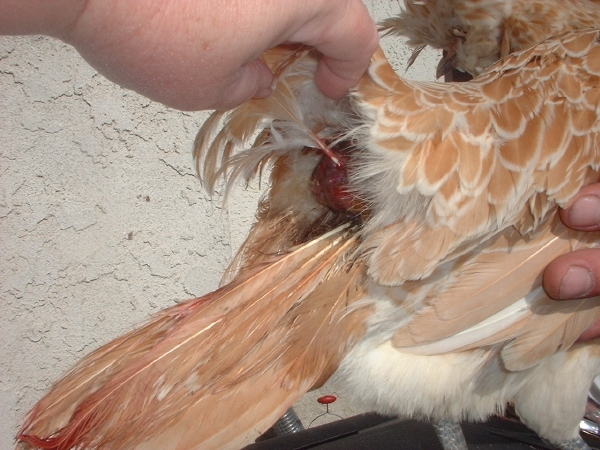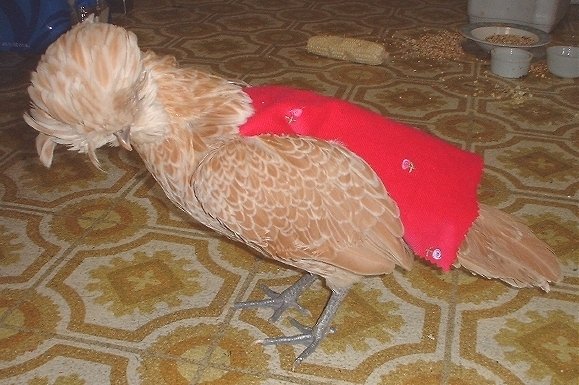
Sometimes this is the first thing you notice-
If you have a bird away from the flock for an extended period of time, to the flock
that bird is dead and gone-
Illness
’My Chicken Is Looking Sick’

Velvet Sparrow
If you suspect illness, please read the ENTIRE ‘Health’ section on my site–I go into much more detail. If you think your chicken needs a vet, CALL ONE! Info on this site is NOT meant to take the place of proper veterinary care, and I assume no responsibility for your use of the information on this site.
This is by no means a complete and comprehensive list of everything that can go wrong with your chickens!
The Chicken Mantra–learn it, love, it, live it:
‘If it is possible for a chicken to hurt themselves on something, somehow they will find a way.’
With ANY injury or illness, it is imperative to keep your bird warm and quiet. Chickens are tough, but are, after all, still birds and shock can kill your bird quicker than an injury or illness can. One of the first things you should do is to get the bird to someplace warm (a cardboard box with a heating pad set on 'low') and quiet (away from other birds, kids, barking dogs) and offer it free choice chicken feed and unflavored electrolyte solution to drink. Pedialyte is a liquid electrolyte solution for human children in the baby aisle at the grocery store or mix your own following the recipe here. Unflavored is best for chickens since they tend to refuse fruit flavored water.
It bears repeating that my site is not the end-
As more and more people start keeping backyard flocks that are pets as well, this is shifting, but slowly. MSU has a great poultry section that describes symptoms & treatments for the most common poultry diseases:
URL: http://msucares.com/poultry/diseases/index.html
There are more links to other helpful sites on the ‘Links’ page of my site.
What Do I Do?!
Basically this is a catch-
Failure To Thrive
Parasites, Worms, Lice & Mites
Parasites, whether internal (worms) or external (mites & lice) can all be treated in a similar way. See the "Worming and Dusting' section for more information. Practice a ‘scorched earth’ policy and don’t suffer the little buggers to infest your flock.
Growths, Lumps & Cysts
My vet tells me that there are upwards of 300 different types of growths, lumps,
cancers, cysts, etc. that chickens can suffer from. If you find a lump, take the
bird to the vet. He will decide it it is a hard tissue lump (growth or cancer most
likely) or a fluid-
Surgery may be possible in some cases, your vet can help you decide if this is the best option for your bird. I once had a Polish hen named Seven who developed a sudden growth at the base of her tail, right near her preen gland. My vet basically said to take her home, make her comfortable and enjoy what time I had left with her. In the meantime, Seven was adamant about digging at the growth–it really annoyed her. She was otherwise perky and normal enough, eating and drinking like always. But she was digging away at the growth and making it bleed, which of course attracted pecking from the other chickens.
In true chicken form, Seven hid her problem at first. We noticed one day that she had some blood on her tail feathers, and that she was no longer carrying her tail upright as Polish normally do. We assumed she had an injury and picked her up for inspection right away.
This is Seven and her sister, Sugar, on the day about 7 months before this when we had gotten them from a local feed store. Seven is on the left, and you can see the upright tail posture of this breed.
Old Age Issues & Special Needs Birds
So Seven got to come inside to live out her remaining days, and I made her a modified
chicken saddle to wear that would cover the growth and keep her from picking at it.
A chicken saddle is simply a cloth ‘apron’ that goes over a hen’s back and is held
in place with elastic and snaps around the wings, and is normally used with valuable
show birds during breeding season to keep the rooster from injuring her with his
spurs or wrecking her feathers. Chicken saddles are also useful if your regular
ol’ backyard hen has suffered a spur wound on her back from an over-
The first saddle I made was more of a tube–a leg cut from an old pair of jeans, which I thought would be perfect.
This is the lump that we found at the base of Seven’s tail, but only after lifting the feathers covering the area. You can see the traces of blood on her tail feathers and that her tail is slightly downward, our only clues that something was amiss.
From the back. It was about the size of a ping-
…and a close-
She looked like a chicken sausage. Sugar thought I was an idiot. After due consideration I decided that she was right.
It was far too heavy for her to be able to stand and walk around in. Also, when you first put something like this on a chicken, they assume that the thing has grabbed them and is about to eat them, so ease them into the idea slowly. If you just throw clothing on a chicken and stand back they are gonna freak RIGHT out. Pet them with it, lay it across their back and allow them to feel it on them and walk out from under it. Go slow.
I removed the Chicken Tube and apologized. She was NOT amused.
…and made her look like Super Chicken.
Really, really not amused.
Super Chicken’s cape is held in place with lengths of elastic going around each wing where it meets her body, with snaps connecting it to the fabric so that it will break away if she gets caught on something.
It only took her about 10 minutes to figure out how to undo the snaps and throw her cape scornfully to the couch cushions below.
Fortunately I was prepared, and Super Chicken’s arch nemesis turned out to be heavy-
After that the cape stayed on and Super Chicken accepted her new duds gracefully.
Saddle #2…
Seven’s was more of a cape since I only needed to cover the wounded area, and the only other fabric I had at the time was, unfortunately, hot pink in color.
 >
>
Jack’s Henhouse
 >
>
Jack’s Henhouse
 >
>
Jack’s Henhouse
 >
>
Jack’s Henhouse
 >
>
Jack’s Henhouse
 >
>
Jack’s Henhouse
 >
>
Jack’s Henhouse
 >
>
Jack’s Henhouse
While not an injury or illness per se, if you plan on keeping your chickens as valued pets and commit to keeping them to the end of their lives, old age and the things that come with it like blindness or chronic joint difficulties are a possibility. You may also have what I call ‘Scratch & Dent Bin’ chickens–birds that may be otherwise healthy but have a bad leg, some bent toes, only one eye, etc. Our local feed store knew that we were a soft touch, and sometimes when we’d go in we’d hear, ‘We have this hen with a twisted leg and only one eye, we can’t sell her, do you want her as a freebie?’ Of course these birds were always the sweetest and most beautiful, but even when they weren’t…well, like I said, we were a soft touch and home they’d come with us. These birds tend to get along just fine, but may sometimes benefit from a little handicap access help from you.
The average life span of a chicken is anywhere from 5-
Old hens tend to retain their status in the pecking order, and usually no youngsters are foolish enough to take on the grand old dignified dames of the flock. A Head Roo who has an up and coming challenger is another thing–there can be only one, and an old Head Roo who gets deposed is a sad thing. You’ll usually have to make the decision as to who is Head Roo in your flock and either rehome one of them or keep a separate run for the old folks and give your old gent and his old ladies their own slice of Heaven.
Old chickens that aren’t getting around so well anymore can benefit from lower roosts no more than 2 feet off the ground and a sloping ladder to walk up and down to get to the roosts. Some older birds forgo roosting entirely and will sleep in nests boxes, piling in together in cold weather. Easy access food and water containers are also a good thing so the the creaky old farts don’t have to climb up to get to them. My old hens of age 10 and up really love a bit of supplemental heat from a barn heater in winter when nighttime temps drop down below freezing.
Deaf birds do fine, but one I raised from a chick had to be taught to watch the other chickens and take visual cues from them–she could not hear me call her to goodies when I was passing them out and missed out quite a bit at first. Once I realized that she was deaf, I started making sure that I was in her field of vision before I started scattering treats and that she was connecting me tossing goodies and seeing the rest of the flock start running over to me. Once she made the connection that when the rest of the flock started running she should run and join them, I no longer had to be in sight–she’d see them run and would join them to see what they were after. This also helped to teach her to watch the flock for visual cues if there was danger, such as a hawk overhead. To avoid startling her, I also had to be careful not to sneak up on her and made sure to approach her where she could see me.
I have had two old hens, on age 9 and the other past 10, go mostly blind–not at the same time, but the things I did to help them deal with it were the same. Both were Polish hens and when I tested them by moving my hand in front of their face, seemed to have a small slice of vision left in one eye. Unfortunately in both cases neither one was able to see well enough to remain with the flock, who tended to peck them because they were unable to pick up on visual pecking order cues or would walk right into another chicken and get pecked for their trouble. Since they were old ladies, we had no second run for them, it was winter and we didn’t expect to have them for long due to their advanced age, they became house chickens. They didn’t quite stumble around in a panic, but did have to relearn ways of doing things. We kept the floor clear of clutter, didn’t rearrange furniture and placed their food and water dishes in the same place all the time. We taught them to respond to auditory cues by calling them and tapping on the food and water dishes to teach them where they were located, they caught on to it within a day or two.
They would also have good days and bad days vision-
Disabled birds benefit mostly from the handicap access I discussed before, once any
injuries has healed. I had a hen that managed to rip her own tongue out (my vet
said it wasn’t uncommon since chickens peck at anything to see if it’s food, and
sometimes may pick up a piece of broken glass or sharp metal) and had to relearn
how to eat. She solved this by picking up a piece of food, holding it in her beak
for a moment and then throwing her head around the food to swallow it! This technique,
although really odd looking, served her perfectly well and she went on for another
8 years, even raising several clutches of baby chicks. Another one-
 >
>
Jack’s Henhouse
 >
>
Jack’s Henhouse
 >
>
Jack’s Henhouse
Ascites Or ‘Water Belly’
This condition can strike older hens, especially those who have fallen out of lay,
are chronic internal layers or are so old that they aren’t getting enough exercise.
Sometimes Ascites goes hand in hand with Fatty Liver Disease, too. Birds with Ascites
retain a straw-
I used a tuberculin syringe to drain an old hen with Ascites the first time I did it–they have a very short needle so I felt at less at risk of puncturing something important. The drawback to tuberculin syringes is that the barrel is small and doesn’t hold much. Larger syringes with longer needles have greater capacity, and once I knew what I was doing and was comfortable with it, I went with one of those.
Video on YouTube showing drainage of a hen with Ascites–if you do this, they tend to drip like a coffee maker for a bit afterwards, so be ready:
URL: http://www.youtube.com/watch?v=AuRyB3gGA2c
Another at a vet’s office, great description on the video page with info:
URL: http://www.youtube.com/watch?v=p_s2CtZc0Ng
Some people have also had success using SAM-
Coccidiosis
Coccidiosis is a common illness caused by a protozoa. Symtoms include listlessness, bloody, loose poops, weight loss, lack of appetite, etc. Recently a variation of Coccidiosis has popped up that does NOT have the trademark bloody poops, so diagnose carefully. It can be treated with Sulfadimethoxine (Albon) or Amprolium (Amprol or Corrid), which still work for coccidiosis, but a chicken expert friend recently told me that Sulfamethazine (Sulmet) is no longer effective, so don't use it to treat cocci! IT IS VERY IMPORTANT TO EDUCATE YOURSELF ON THE SYMPTOMS OF DISEASE. The less time you spend frantically searching in books or online, trying to diagnose what the heck is wrong with your chicken THIS time, the better. Spending a few minutes a day with your flock simply observing them is one of the best ways for you to spot a bird that is 'off' quickly. MSU has a FANTASTIC poultry site with tons of great information, read as much of it was you can. This section deals with common illness, how to spot them and how to treat:
Moet, the tongueless bantam buff Frizzle Cochin hen, went on to successfully foster & raise three different clutches of baby chicks, and lived to age 10.
Baby, the Kraienkoppe hen, was a freebie from the feed store and has only one eye and a twisted foot. She is 9 years old and one of the top hens in the pecking order.

Enjoying the chickens? Has my site helped you?
Want to buy the chickens some goodies?
Click the button!



 >
>








